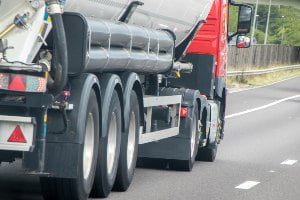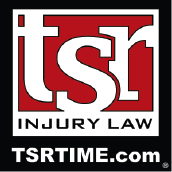Guide to Hazardous Material Truck Crashes in Minneapolis

Hazmat truck crashes are rare, but in the past 10 years, the number of hazardous material truck crashes across the U.S. has been on the rise. In fact, according to a CBS News analysis of U.S. Department of Transportation data, these crashes have increased by 155 percent.
While any commercial truck crash is dangerous, hazmat truck accidents add an additional layer of danger. Crash victims could suffer injuries in the crash, as well as exposure to toxic materials that could lead to long-term injuries and medical issues.
At TSR Injury Law, our Minneapolis truck accident lawyers know how devastating commercial truck crashes can be, including those involving toxic cargo. Below, we discuss what drivers in Minneapolis should know about these situations, including liability and seeking compensation.
Call today for legal assistance. No upfront fees. (612) TSR-TIME
What Is the Definition of a Hazmat Truck?
A hazmat truck is a commercial truck that is specifically designated and authorized to transport hazardous materials, such as flammable liquids, explosives or acids. Hazmat trucks come in many shapes and sizes, depending on the types of hazardous materials they are transporting.
There is an extra layer of danger in operating a hazmat truck, which is why drivers must have a specific endorsement certifying they have been trained on how to safely transport hazardous cargo. Hazmat truck drivers are often required to pass a special type of background check to further ensure drivers will take the proper safety precautions.
Hazmat trucks are also required to have more liability insurance than other commercial trucks because of the additional danger their cargo poses.
Types of Hazardous Materials Carried By Commercial Trucks
The Federal Motor Carrier Safety Administration (FMCSA) created nine classes of hazardous materials, which include:
- Class 1: Explosive materials – These are combustible materials that carry a risk of explosion, such as dynamite, flares, fireworks, ammunition and blasting agents.
- Class 2: Compressed gases – This class includes compressed gases that are flammable or non-flammable, such as propane, helium and fluorine.
- Class 3: Flammable liquids – Examples of substances in this class include gas, jet fuel, motor oil and ethanol.
- Class 4: Flammable solids and spontaneously combustible materials – This class includes materials like activated charcoal, sulfur and aluminum powder.
- Class 5: Oxidizers and organic peroxides – These are substances that help burn other materials, like ammonium nitrate.
- Class 6: Toxic materials and infectious biological substance – This class includes things like rat poison, potassium cyanide and infectious viruses, like anthrax, Hepatitis B and Marburg virus.
- Class 7: Radioactive substances – There are numerous examples of radioactive substances, such as uranium.
- Class 8: Corrosive substances – These are substances that can quickly corrode or burn other substances, like battery fluid and other strong acids.
- Class 9: Miscellaneous materials – Substances that do not fall into any other classes are considered miscellaneous. Common examples include lithium-ion batteries and dry ice.
Injuries That May Result From a Hazmat Truck Crash
Commercial truck accidents with smaller passenger vehicles, bicyclists or pedestrians can cause a variety of severe injuries, from soft-tissue damage to traumatic brain injuries, spinal cord injuries and amputations.
Hazmat truck crashes also create a risk of exposure to toxic chemicals that could cause serious or life-threatening illness. Once toxic substances become airborne, they can no longer be contained and even people miles away from the crash site could be in danger of breathing in toxic fumes.
In some cases, toxic substances cause short-term symptoms, like skin or eye irritation. However, others could develop a range of permanent respiratory or neurological problems or increase your risk of other dangerous medical conditions later in life. For example, exposure to a high dose of radiation could increase the risk of cancer.
Hazmat trucks often carry flammable substances that could cause large explosions. These explosions could cause serious or life-threatening burn injuries to those nearby, along with smoke-inhalation injuries. The substances that burn may also be toxic, increasing your risk of respiratory or neurological complications.
Safety Violations That Could Cause the Release of Toxic Substances
Despite the best efforts of the driver and the company that loaded the hazardous cargo, toxic substances could leak out in a crash. While the truck driver may have been cautious about loading the cargo, he or she may have been negligent behind the wheel, causing the crash. For example, the driver may have been speeding, distracted or making an unsafe turn or lane change.
Unfortunately, drivers and other parties are not always as cautious as they should be about securing hazardous cargo. There may have been various violations of FMCSA regulations on transporting hazardous materials. In fact, the FMCSA maintains a dashboard of HazMat violations. These are some of the most common violations for the 2023 fiscal year, as of September 28:
- Package not secured in trailer – 3,427 violations
- Transporting materials that were not prepared according to regulations – 639 violations
- Failure to properly mark the cargo with tank with an emergency shutoff – 617
- Failure to maintain or make emergency response information accessible – 1,398
There are specific rules about the loading, transporting and unloading of bulk tanks, and if these rules are not followed, it puts others at risk of exposure to toxic or flammable materials. There are also rules on which materials can be loaded together and which ones should not be loaded together.
Improper labeling could result in crash victims not knowing they were exposed to toxic substances during and after the collision. This could result in a delay in medical treatment, which could increase the risk of permanent illness.
Who Can Be Held Liable For a Hazmat Truck Crash?
While truck drivers are often held liable for truck crashes, their employers may also be vicariously liable. They may have been negligent in the hiring process or in the process of ensuring hazardous materials were handled properly. Trucking companies may have let a truck continue to be on the road even though it had failed inspections. The owner of the hazardous cargo may also bear liability for improper labeling and any other oversights.
Why You Need an Experienced Lawyer To Manage Your Claim
It takes an in-depth investigation to determine liability for a hazmat truck crash. This includes everything from reviewing state and federal regulations and trucking company records, to hiring a crash reconstruction expert and pulling black box details from the vehicles involved. You also need to know what to look for and what steps to take to quickly preserve evidence before it is altered or lost.
These are just a few of the many reasons victims need help from an experienced law firm. We know commercial truck crashes can result in life-changing injuries, and hiring the right law firm is the first step in determining who may be liable for the crash and which insurance policies are involved.
Are You a Victim of a Minneapolis Truck Crash? Call TSR Injury Law
Commercial truck crash victims need experienced legal assistance. These cases are not the same as car accident cases. There are so many factors involved in a commercial truck crash case, including powerful insurance companies and trucking companies fighting hard to avoid accountability.
At TSR Injury Law, we level the legal playing field, fighting for the best interests of those injured by another’s negligence. Like you, our goal is to secure maximum compensation for your injuries and damages.
Our legal services come with no upfront costs or obligations.
Give us a call today to discuss how we may be able to help you: (612) TSR-TIME.



